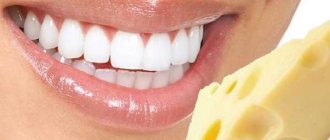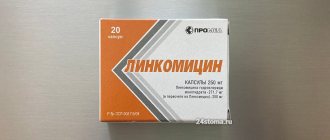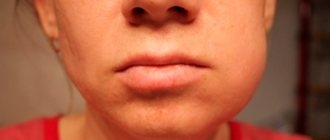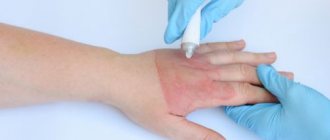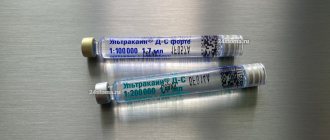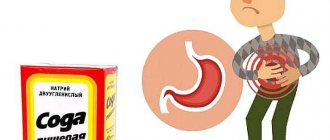Lincomycin is a broad spectrum antibiotic. And if you take into account the diversity of microflora in the oral cavity, it becomes clear why dentists often prefer this particular drug.
The action of lincomycin is based on the suppression of the vital activity of pathogenic as well as opportunistic microorganisms. Including staphylococci, viridans streptococcus and many other microbes resistant to other antibiotics. It is characteristic that microbial resistance directly to lincomycin develops over a fairly long time.
pharmachologic effect
Lincomycin hydrochloride is an antibiotic from the lincosamide group. When using therapeutic doses of this drug, it has a bacteriostatic effect on the body. The use of higher concentrations of the active substance provides a bactericidal effect. The antibiotic suppresses the processes of protein synthesis in the cells of pathogenic microorganisms. Basically, the active ingredient demonstrates activity against gram-positive bacteria. Most gram-negative bacteria, viruses, fungi, and protozoa are resistant to lincomycin. Resistance develops relatively slowly.
There is cross-resistance of microflora to clindamycin, lincomycin, as well as other antibacterial agents that belong to the lincosamide group.
Lincomycin 30% 1ml No. 10 Solution for Injection
LINCOMYCIN
The scientific information provided is general and cannot be used to make a decision about the possibility of using a particular drug.
pharmachologic effect
Antibiotic of the lincosamide group. In therapeutic doses it acts bacteriostatically. At higher concentrations it has a bactericidal effect. Suppresses protein synthesis in microbial cells.
Active primarily against aerobic gram-positive bacteria: Staphylococcus spp. (including strains producing penicillinase), Streptococcus spp. (including Streptococcus pneumoniae /except Enterococcus faecalis/), Corynebacterium diphtheriae; anaerobic bacteria Clostridium spp., Bacteroides spp.
Lincomycin is also active against Mycoplasma spp.
Most gram-negative bacteria, fungi, viruses, and protozoa are resistant to lincomycin. Resilience is developed slowly.
Cross-resistance exists between lincomycin and clindamycin.
Pharmacokinetics
After oral administration, 30-40% is absorbed from the gastrointestinal tract. Eating slows down the rate and extent of absorption. Lincomycin is widely distributed in tissues (including bone) and body fluids. Penetrates through the placental barrier. Partially metabolized in the liver. T1/2 is about 5 hours. It is excreted unchanged and in the form of metabolites in urine, bile and feces.
Indications
Severe infectious and inflammatory diseases caused by microorganisms sensitive to lincomycin, incl. sepsis, osteomyelitis, septic endocarditis, pneumonia, lung abscess, pleural empyema, wound infection. As a reserve antibiotic for infections caused by strains of staphylococcus and other gram-positive microorganisms resistant to penicillin and other antibiotics.
For external use: purulent-inflammatory skin diseases.
ICD-10 codes
Dosage regimen
When taken orally by adults - 500 mg 3-4 times / day or intramuscularly - 600 mg 1-2 times / day. 600 mg is administered intravenously in 250 ml of isotonic sodium chloride or glucose solution 2-3 times a day.
Children aged 1 month to 14 years orally - 30-60 mg/kg/day; administered intravenously at a dose of 10-20 mg/kg every 8-12 hours.
For external use, apply a thin layer to the affected areas of the skin.
Side effect
From the digestive system: nausea, vomiting, epigastric pain, diarrhea, glossitis, stomatitis; transient increase in the level of liver transaminases and bilirubin in the blood plasma; with long-term use in high doses, the development of pseudomembranous colitis is possible.
From the hematopoietic system: reversible leukopenia, neutropenia, thrombocytopenia.
Allergic reactions: urticaria, exfoliative dermatitis, Quincke's edema, anaphylactic shock.
Effects due to chemotherapy: candidiasis.
Local reactions: phlebitis (with intravenous administration).
With rapid intravenous administration: decreased blood pressure, dizziness, general weakness, relaxation of skeletal muscles.
Contraindications for use
Severe liver and/or kidney dysfunction, pregnancy, lactation, hypersensitivity to lincomycin and clindamycin.
Use during pregnancy and breastfeeding
Lincomycin crosses the placental barrier and is excreted in breast milk. Use during pregnancy is contraindicated. If it is necessary to use it during lactation, the issue of stopping breastfeeding should be decided.
Use for liver dysfunction
Contraindicated in cases of severe liver dysfunction.
If liver function is impaired, the single dose of lincomycin should be reduced by 1/3 - 1/2 and the interval between doses should be increased. With long-term use, systematic monitoring of liver function is necessary.
Use for renal impairment
Contraindicated in cases of severe renal impairment.
If renal function is impaired, the single dose of lincomycin should be reduced by 1/3 - 1/2 and the interval between doses should be increased. With long-term use, systematic monitoring of renal function is necessary.
Use in children
Children aged 1 month to 14 years orally - 30-60 mg/kg/day; administered intravenously at a dose of 10-20 mg/kg every 8-12 hours.
Pharmacokinetics and pharmacodynamics
The active substance is well absorbed from the gastrointestinal tract, its highest concentration in the blood is observed 0.5-1 hour after intramuscular administration. 72% bound to blood proteins. Penetrates the placenta and is detected in breast milk. Does not pass through the blood-brain barrier well. The substance is partially metabolized in the liver. Its half-life is approximately 5 hours. It is excreted from the body both unchanged and as metabolites.
It is excreted from the body through the kidneys, as well as with feces and bile. After intramuscular administration, the therapeutic concentration in the blood of lincomycin is maintained for 17-20 hours; if the drug is administered intravenously, then for 14 hours.
Release forms of lincomycin
Lincomycin is available in several forms:
- in the form of capsules,
- solutions for injections,
- in the form of an ointment.
Dentists often use it locally in the form of infiltration injections. This type of administration is preferable because lincomycin forms a drug depot in the bone tissue of the jaw, thereby prolonging and improving its effect.
But, despite this, the choice of one form or another of an antibiotic depends on the purpose, as well as the nature of the inflammation.
In addition to the above forms of lincomycin, the so-called diplen-denta-l, which are special self-adhesive films, are currently widely used. Most often they are used in the complex treatment of periodontitis, both local and generalized.
Side effects
During treatment with the drug, the following side effects may occur:
- Digestive system: diarrhea , vomiting, nausea, abdominal pain, stomatitis, glossitis.
- Hematopoietic system: neutropenia, reversible leukopenia, thrombocytopenia.
- Allergic manifestations: dermatitis , urticaria , anaphylactic shock , Quincke's edema .
- Candidiasis.
phlebitis may occur as a local reaction .
In the case of rapid intravenous administration, the patient may experience a decrease in blood pressure, general weakness and dizziness, and relaxation of the skeletal muscles.
Long-term treatment with large doses of the drug can lead to the manifestation of pseudomembranous colitis .
Lincomycin
Lincomycin is an antibiotic from the lincosamide group. Unlike, say, ampicillin synthesized in the laboratory, lincomycin is a natural product of the vital activity of microorganisms: it is produced by the actinomycetes Streptomyces lincolnensis and some of their “relatives”. The mechanism of action of lincomycin is similar to that of gentamicin: the antibiotic binds to the 50S (gentamicin - to the 30S) subunit of ribosomes and most directly interferes with the formation of peptide bonds, as a result of which the reading of genetic information is disrupted and defective proteins are synthesized at the output. True, unlike the same gentamicin, lincomycin forms reversible bonds with the receptors of the specified ribosomal unit, which are subsequently broken, hence the nature of the pharmacological effect: not bactericidal (destroying), but bacteriostatic, inhibiting the growth and development of microorganisms. However, lincomycin in high doses can also have a bactericidal effect. This statement is also true for average dosages of the drug in relation to bacteria highly sensitive to lincomycin.
Lincomycin is successfully used in the fight against infections caused by gram-positive (Staphylococcus spp., Streptococcus spp., Corynebacterium diphtheriae, Clostridium spp.) and gram-negative (Bacteroides spp., Mycoplasma spp.) microorganisms.
The special value of lincomycin is that it is effective against bacteria that exhibit resistance to a number of other antibiotics, for example, the same notorious Staphylococcus spp. Resistance to lincomycin develops slowly, but cross-resistance may also occur (for example, between lincomycin and clindamycin).
Lincomycin's disadvantages are helplessness against gram-negative bacteria, Enterococcus spp., viruses, fungi, protozoa, relative uselessness in the fight against Neisseria spp., Corynebacterium spp., spore-forming anaerobes (in any case, lincomycin is clearly inferior to erythromycin here).
Lincomycin is available in capsules, solution for intravenous and intramuscular injections and ointment for external use (“Lincomycin-akos”). Capsules are taken 1-2 hours before meals. Recommended doses: 1-1.5 g daily and 0.5 g single (for adults) and 30-60 mg per 1 kg daily (for children). The duration of the antibacterial course is on average 1-2 weeks. For the injection form of lincomycin, the daily dose is 1.8 g (adults) and 10-20 mg per 1 kg (children). Long-term therapeutic courses require careful monitoring of the activity of the liver and kidneys. Lincomycin ointment is used externally: it is applied in a thin layer to the infected area of the skin 2-3 times a day.
Instructions for use (Method and dosage)
If the patient has been prescribed Lincomycin hydrochloride, the instructions for use during treatment must be followed.
The instructions for Lincomycin hydrochloride in ampoules provide for the possibility of intravenous and intramuscular administration of the drug.
When the drug is prescribed intramuscularly, adult patients receive 600 mg per day, administered 1-2 times.
Intravenous drip administration is practiced, with 600 mg of the drug dissolved in 250 ml of glucose or isotonic sodium chloride solution, administration can be carried out 2-3 times a day.
Children who are already 1 month old and who develop severe infectious diseases are prescribed intramuscular administration of the drug; the dosage is determined as follows: per 1 kg of body weight, 10 mg of the drug. The drug is administered every 12 hours. Intravenous administration is possible, the dose is 10-20 mg/kg per day.
Indications for use
- gingivitis,
- periodontitis,
- periodontitis,
- osteomyelitis,
- periostitis,
- bone grafting of the jaw,
- dental implantation, etc.
In the treatment of inflammatory processes in the oral cavity, lincomycin plays an important, but not decisive, role. That is why it is successfully used in complex treatment. For example, when treating periodontitis, first of all, it is necessary to remove the source and result of the inflammatory process, and lincomycin, in turn, helps the body recover and prevent various kinds of complications.
Interaction
If the drug is treated simultaneously with cephalosporins , penicillins , chloramphenicol , erythromycin , antagonism of the antimicrobial effect may be observed.
Simultaneous administration with aminoglycosides may provoke synergistic action.
If Lincomycin Hydrochloride is taken at the same time and drugs for inhalation anesthesia or peripherally acting muscle relaxants are used, neuromuscular blockade may increase, and apnea .
With simultaneous treatment with antidiarrheals, a decrease in the effect of lincomycin is observed.
The product is incompatible with barbiturates , ampicillin , calcium gluconate , heparin , theophylline , magnesium sulfate .
Novobiocin and Kanamycin should not be combined in one syringe or dropper .
Lincomycin hydrochloride (amp. 30% 1ml No. 10)
A country
Belarus, Russia
The country of production may vary depending on the batch of goods. Please check with the operator for detailed information when confirming your order.
Active substance
Lincomycin
Compound
1 ampoule contains: lincomycin (in the form of hydrochloride monohydrate) 300 mg
pharmachologic effect
Antibiotic of the lincosamide group. In therapeutic doses it acts bacteriostatically. At higher concentrations it has a bactericidal effect. Suppresses protein synthesis in microbial cells. Active primarily against aerobic gram-positive bacteria: Staphylococcus spp. (including strains producing penicillinase), Streptococcus spp. (including Streptococcus pneumoniae /except Enterococcus faecalis/), Corynebacterium diphtheriae; anaerobic bacteria Clostridium spp., Bacteroides spp. Lincomycin is also active against Mycoplasma spp. Most gram-negative bacteria, fungi, viruses, and protozoa are resistant to lincomycin. Resilience is developed slowly. Cross-resistance exists between lincomycin and clindamycin.
Indications for use
Severe infectious and inflammatory diseases caused by microorganisms sensitive to lincomycin, incl. sepsis, osteomyelitis, septic endocarditis, pneumonia, lung abscess, pleural empyema, wound infection. As a reserve antibiotic for infections caused by strains of staphylococcus and other gram-positive microorganisms resistant to penicillin and other antibiotics. For external use: purulent-inflammatory skin diseases.
Mode of application
When taken orally by adults - 500 mg 3-4 times / day or intramuscularly - 600 mg 1-2 times / day. 600 mg is administered intravenously in 250 ml of isotonic sodium chloride or glucose solution 2-3 times a day. Children aged 1 month to 14 years orally - 30-60 mg/kg/day; It is administered intravenously at a dose of 10-20 mg/kg every 8-12 hours. For external use, apply a thin layer to the affected areas of the skin.
Interaction
When used simultaneously with penicillins, cephalosporins, chloramphenicol or erythromycin, antagonism of the antimicrobial effect is possible. When used simultaneously with aminoglycosides, synergistic action is possible. When used simultaneously with inhalation anesthesia or peripherally acting muscle relaxants, an increase in neuromuscular blockade is observed, up to the development of apnea. Taking antidiarrheal drugs reduces the effect of lincomycin. Pharmaceutical interactions Pharmaceutically incompatible with ampicillin, barbiturates, theophylline, calcium gluconate, heparin and magnesium sulfate. Lincomycin is incompatible in the same syringe or dropper with kanamycin or novobiocin.
Side effect
From the digestive system: nausea, vomiting, epigastric pain, diarrhea, glossitis, stomatitis; transient increase in the level of liver transaminases and bilirubin in the blood plasma; with long-term use in high doses, the development of pseudomembranous colitis is possible. From the hematopoietic system: reversible leukopenia, neutropenia, thrombocytopenia. Allergic reactions: urticaria, exfoliative dermatitis, Quincke's edema, anaphylactic shock. Effects due to chemotherapy: candidiasis. Local reactions: phlebitis (with intravenous administration). With rapid intravenous administration: decreased blood pressure, dizziness, general weakness, relaxation of skeletal muscles.
Contraindications
Severe liver and/or kidney dysfunction, pregnancy, lactation, hypersensitivity to lincomycin and clindamycin.
Use in children Children aged 1 month to 14 years orally - 30-60 mg/kg/day; administered intravenously at a dose of 10-20 mg/kg every 8-12 hours.
Overdose
If an overdose of Lincomycin hydrochloride occurs, the symptoms that are described as side effects from the digestive system may appear - diarrhea, nausea, vomiting. If the undiluted drug is administered rapidly, there is a risk of cardiac arrest. There are no specific antidotes; symptomatic treatment is carried out.
special instructions
If liver and/or kidney function is impaired, the single dose of lincomycin should be reduced by 1/3-1/2 and the interval between doses should be increased. With long-term use, systematic monitoring of kidney and liver functions is necessary. If pseudomembranous colitis develops, lincomycin should be discontinued and vancomycin or bacitracin should be prescribed.
Dispensing conditions in pharmacies
On prescription
special instructions
If the patient has impaired liver or kidney function, the dosage should be reduced or the period between administration of the drug should be increased. If the drug is used for a long period, it is necessary to systematically monitor the functions of the liver, kidneys, as well as laboratory blood parameters.
The drug is prescribed with caution for the treatment of people with a tendency to allergies, patients with colitis , bronchial asthma , as well as those with a history of gastrointestinal diseases.
If the patient develops pseudomembranous colitis , it is necessary to stop taking the drug.
Main contraindications for use
- severe dysfunction of the kidneys and liver,
- hypersensitivity to the drug,
- pregnancy and lactation.
This drug should not be used during pregnancy, as it passes through the placental barrier. In addition, this antibiotic passes into breast milk, so if treatment with lincomycin is necessary, breastfeeding should be stopped.
Lincomycin is a relatively “old” antibiotic, but despite this, it is very effective. That is why this drug is so valued in dental practice.

